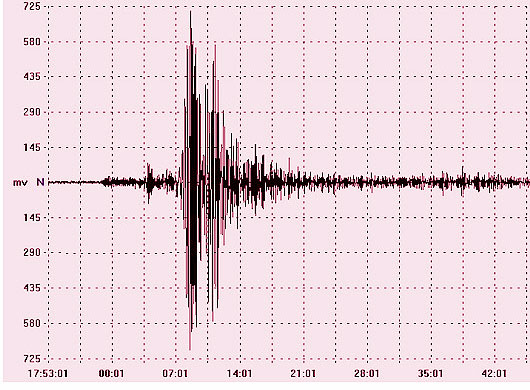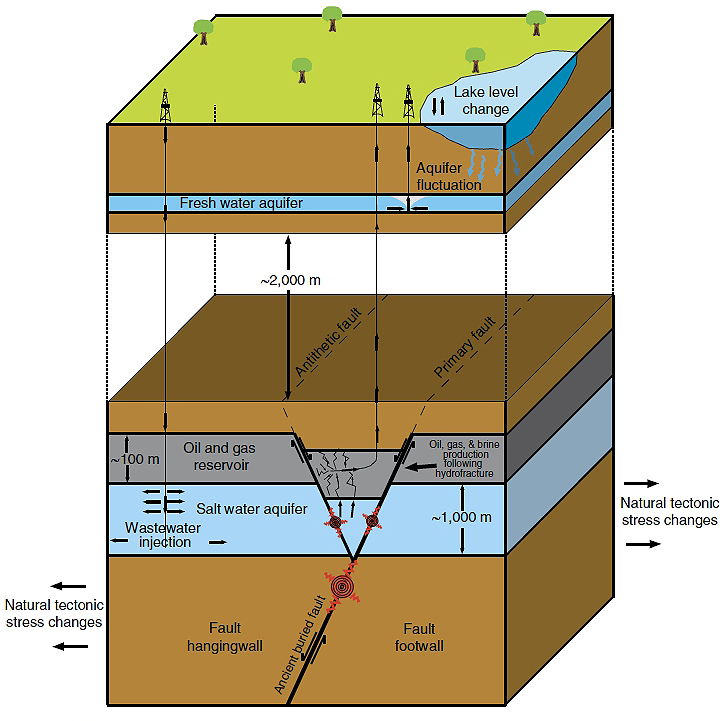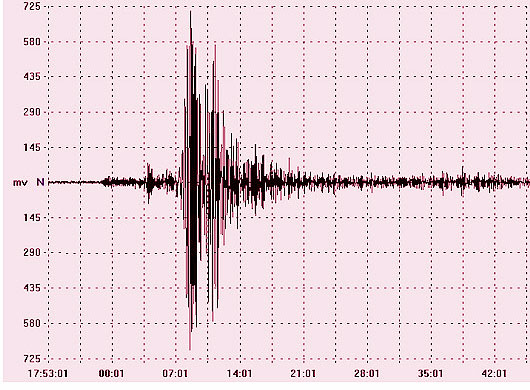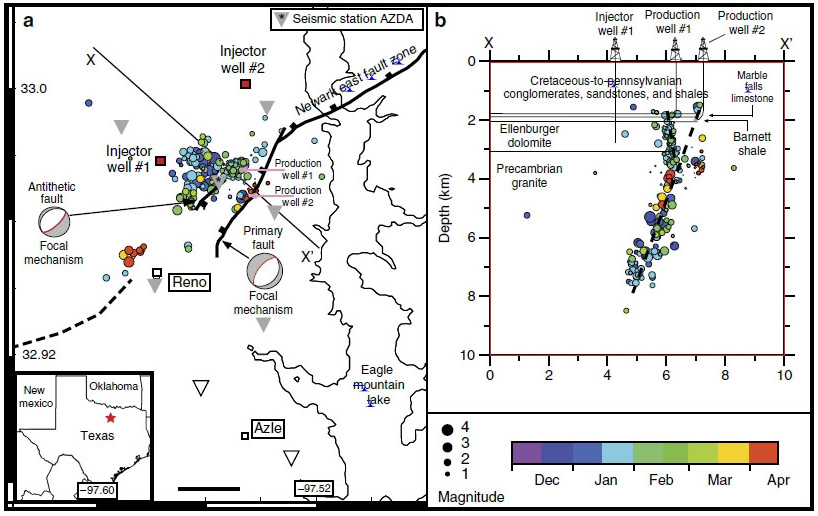SMU-led seismology team reveals Azle findings:
Gas field fluid injection and removal is the most likely cause of 2013-14 earthquakes near Azle.

DALLAS (SMU) – An SMU-led seismology team finds that high volumes of wastewater injection combined with saltwater (brine) extraction from natural gas wells is the most likely cause of earthquakes occurring near Azle, Texas, from late 2013 through spring 2014.
|
>>> Read the full report published in Nature Communications <<< Natural and man-made stress changes that cause earthquakes  Natural and anthropogenic stress changes that may trigger earthquakes in the Azle area. Several natural and anthropogenic (man-made) factors can influence the subsurface stress regime resulting in earthquakes. Read more in the full report. |
In an area where the seismology team identified two intersecting faults, they developed a sophisticated 3D model to assess the changing fluid pressure within a rock formation in the affected area. They used the model to estimate stress changes induced in the area by two wastewater injection wells and the more than 70 production wells that remove both natural gas and significant volumes of salty water known as brine.
Conclusions from the modeling study integrate a broad-range of estimates for uncertain subsurface conditions. Ultimately, better information on fluid volumes, flow parameters, and subsurface pressures in the region will provide more accurate estimates of the fluid pressure along this fault.
“The model shows that a pressure differential develops along one of the faults as a combined result of high fluid injection rates to the west and high water removal rates to the east,” said Matthew Hornbach, SMU associate professor of geophysics. “When we ran the model over a 10-year period through a wide range of parameters, it predicted pressure changes significant enough to trigger earthquakes on faults that are already stressed.” Model-predicted stress changes on the fault were typically tens to thousands of times larger than stress changes associated with water level fluctuations caused by the recent Texas drought.
“What we refer to as induced seismicity – earthquakes caused by something other than strictly natural forces – is often associated with subsurface pressure changes,” said Heather DeShon, SMU associate professor of geophysics. “We can rule out stress changes induced by local water table changes. While some uncertainties remain, it is unlikely that natural increases to tectonic stresses led to these events.”
DeShon explained that some ancient faults in the region are more susceptible to movement – “near critically stressed” – due to their orientation and direction. “In other words, surprisingly small changes in stress can reactivate certain faults in the region and cause earthquakes,” DeShon said.
The study, “Causal Factors for Seismicity near Azle, Texas,” has been published in the journal Nature Communications. The study was produced by a team of scientists from SMU’s Department of Earth Sciences in Dedman College of Humanities and Sciences, the U.S. Geological Survey, the University of Texas Institute for Geophysics and the University of Texas Department of Petroleum and Geosystems Engineering. SMU scientists Hornbach and DeShon are the lead authors.
 Learn more about the North Texas Earthquake Study. |
SMU seismologists have been studying earthquakes in North Texas since 2008, when the first series of felt tremors hit near DFW International Airport between Oct. 30, 2008, and May 16, 2009. Next came a series of quakes in Cleburne between June 2009 and June 2010, and this third series in the Azle-Reno area northwest of Fort Worth occurred between November 2013 and January 2014.
The SMU team also is studying an ongoing series of earthquakes in the Irving-Dallas area that began in April 2014.
In both the DFW sequence and the Cleburne sequence, the operation of injection wells used in the disposal of natural gas production fluids was listed as a possible cause of the seismicity. The introduction of fluid pressure modeling of both industry activity and water table fluctuations in the Azle study represents the first of its kind, and has allowed the SMU team to move beyond assessment of possible causes to the most likely cause identified in this report.
Prior to the DFW Airport earthquakes in 2008, an earthquake large enough to be felt had not been reported in the Fort Worth Basin since 1950. The North Texas earthquakes of the last seven years have all occurred in areas developed for natural gas extraction from a geologic formation known as the Barnett Shale. The Texas Railroad Commission reports that production in the Barnett Shale grew exponentially from 216 million cubic feet a day in 2000, to 4.4 billion cubic feet a day in 2008, to a peak of 5.74 billion cubic feet of gas a day in 2012.
While the SMU Azle study adds to the growing body of evidence connecting some injection wells and, to a lesser extent, some oil and gas production to induced earthquakes, SMU’s team notes that there are many thousands of injection and/or production wells that are not associated with earthquakes.
The area of study addressed in the report is in the Newark East Gas Field (NEGF), north and east of Azle. In this field, hydraulic fracturing is applied to loosen and extract gas trapped in the Barnett Shale, a sedimentary rock formation formed approximately 350 million years ago. The report explains that along with natural gas, production wells in the Azle area of the NEGF can also bring to the surface significant volumes of water from the highly permeable Ellenburger Formation – both naturally occurring brine as well as fluids that were introduced during the fracking process.
Subsurface fluid pressures are known to play a key role in causing seismicity. A primer produced by the U.S. Department of Energy explains the interplay of fluids and faults:
“The fluid pressure in the pores and fractures of the rocks is called the ‘pore pressure.’ The pore pressure acts against the weight of the rock and the forces holding the rock together (stresses due to tectonic forces). If the pore pressures are low (especially compared to the forces holding the rock together), then only the imbalance of natural in situ earth stresses will cause an occasional earthquake. If, however, pore pressures increase, then it would take less of an imbalance of in situ stresses to cause an earthquake, thus accelerating earthquake activity. This type of failure…is called shear failure. Injecting fluids into the subsurface is one way of increasing the pore pressure and causing faults and fractures to “fail” more easily, thus inducing an earthquake. Thus, induced seismicity can be caused by injecting fluid into the subsurface or by extracting fluids at a rate that causes subsidence and/or slippage along planes of weakness in the earth.”
All seismic waveform data used in the compilation of the report are publically available at the IRIS Data Management Center. Wastewater injection, brine production and surface injection pressure data are publicly available at the Texas Railroad Commission (TRC). Craig Pearson at the TRC, Bob Patterson from the Upper Trinity Groundwater Conservation District; scientists at XTO Energy, ExxonMobil, MorningStar Partners and EnerVest provided valuable discussions and, in some instances, data used in the completion of the report.
“This report points to the need for even more study in connection with earthquakes in North Texas,” said Brian Stump, SMU’s Albritton Chair in Earth Sciences. “Industry is an important source for key data, and the scope of the research needed to understand these earthquakes requires government support at multiple levels.”
# # #
In The News
(A sampling of media coverage of this report)
The Associated Press: Study links swarm of quakes in Texas to natural gas drilling
Reuters news service: Small north Texas quakes likely linked to oil, gas operations - study
KERA public radio: SMU Study Links Azle Earthquake Swarm To Natural Gas Drilling
The Wall Street Journal: New Studies Link Earthquakes With Oil, Gas Drilling
The Dallas Morning News: Despite Azle quake study, agency not planning to suspend drilling
The Dallas Business Journal: Oil and gas activity did cause Azle earthquakes, SMU researchers say
The Fort Worth Star-Telegram: Study links Azle earthquakes to drilling activity
The Dallas Observer: New Study Says 2013 North Texas Quakes Likely Caused by Oil and Gas Activity
The Texas Tribune: Study: Gas Activities "Most Likely" Caused Texas Quakes
PhysOrg: Study links swarm of quakes in Texas to natural gas drilling
The Weatherford Democrat: Researchers: Azle earthquakes likely caused by oil and gas activity

